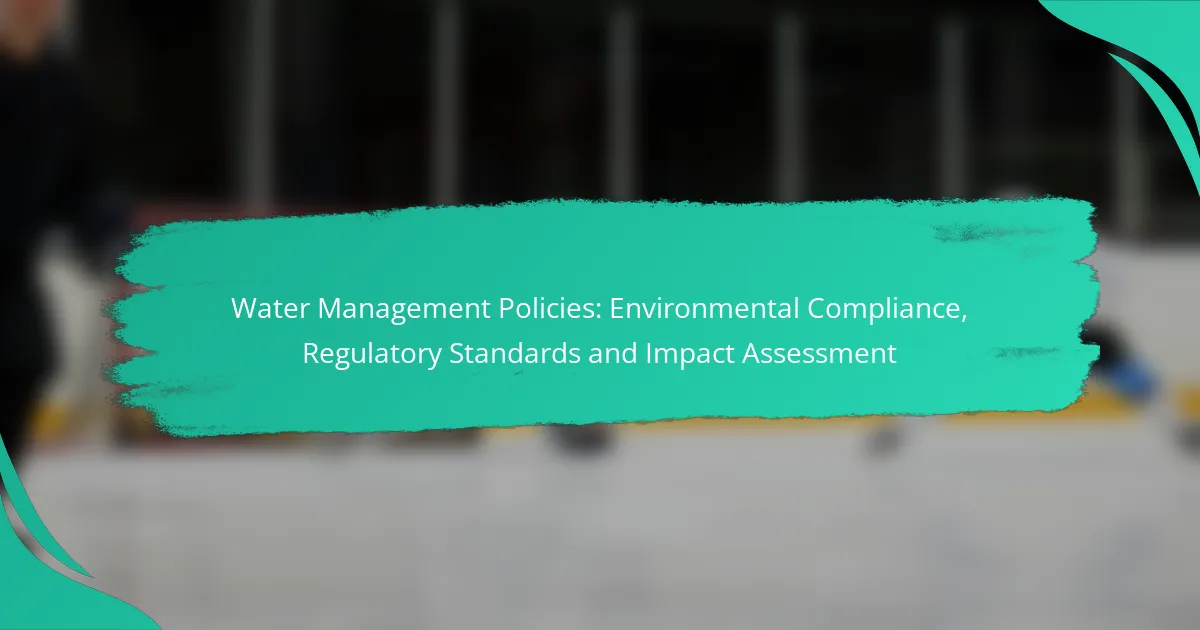Water management policies play a crucial role in ensuring the sustainability and safety of water resources through comprehensive regulatory frameworks and compliance measures. By establishing guidelines that protect water quality and promote responsible usage, these policies aim to safeguard public health and maintain ecological balance. Adherence to regulatory standards and impact assessments is essential for minimizing pollution and managing water resources effectively.
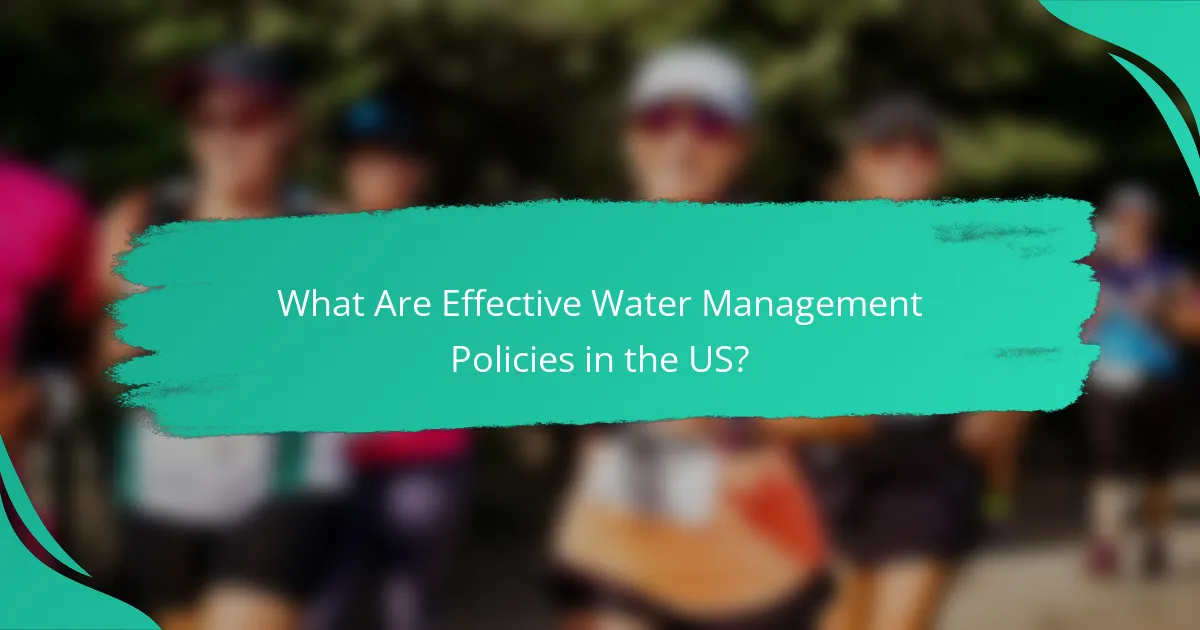
What Are Effective Water Management Policies in the US?
Effective water management policies in the US focus on ensuring the sustainability and safety of water resources through regulatory frameworks and compliance measures. These policies aim to protect water quality, safeguard public health, and promote responsible usage of water resources.
Clean Water Act
The Clean Water Act (CWA) is a key piece of legislation that regulates discharges of pollutants into US waters and sets quality standards for surface waters. It aims to restore and maintain the integrity of the nation’s waters by controlling point source pollution and providing funding for wastewater treatment facilities.
Under the CWA, states are required to develop water quality standards and identify water bodies that do not meet these standards. This process often involves monitoring and assessing water quality, which can lead to the implementation of Total Maximum Daily Loads (TMDLs) for specific pollutants.
Safe Drinking Water Act
The Safe Drinking Water Act (SDWA) ensures the quality of Americans’ drinking water by setting standards for water suppliers. This act empowers the Environmental Protection Agency (EPA) to establish regulations that protect public health from contaminants in drinking water.
Utilities must regularly test water quality and report findings to consumers. Common contaminants regulated under the SDWA include bacteria, nitrates, and heavy metals. Compliance with these standards is critical for maintaining public trust and health.
National Pollutant Discharge Elimination System
The National Pollutant Discharge Elimination System (NPDES) is a permit program under the Clean Water Act that controls water pollution by regulating point sources that discharge pollutants into US waters. Facilities such as factories and wastewater treatment plants must obtain NPDES permits to legally discharge pollutants.
Permits include specific limits on the types and amounts of pollutants that can be discharged, along with monitoring and reporting requirements. Understanding the NPDES process is essential for industries to ensure compliance and avoid penalties, which can be significant.

How Do Water Management Policies Ensure Environmental Compliance?
Water management policies ensure environmental compliance by establishing guidelines and standards that protect water resources from pollution and overuse. These policies require adherence to regulatory frameworks, monitoring practices, and impact assessments to maintain ecological balance and safeguard public health.
Regulatory Frameworks
Regulatory frameworks for water management include a variety of laws and guidelines that dictate how water resources should be managed. In the United States, for example, the Clean Water Act sets standards for water quality and regulates pollutant discharges into water bodies. Similarly, the European Union has directives like the Water Framework Directive that aim to achieve good water status across member states.
These frameworks often require permits for water extraction and discharge, ensuring that activities do not exceed sustainable limits. Compliance with these regulations is crucial for organizations to avoid penalties and contribute to environmental protection.
Monitoring and Reporting Requirements
Monitoring and reporting requirements are essential components of water management policies that help ensure compliance with environmental standards. Organizations are typically required to regularly test water quality and report findings to regulatory bodies. This may include measuring parameters such as pH, turbidity, and the presence of contaminants.
Effective monitoring programs can help identify pollution sources and track changes over time. Organizations should establish clear protocols for data collection and reporting to ensure transparency and accountability. Regular audits and assessments can also help in maintaining compliance and improving water management practices.
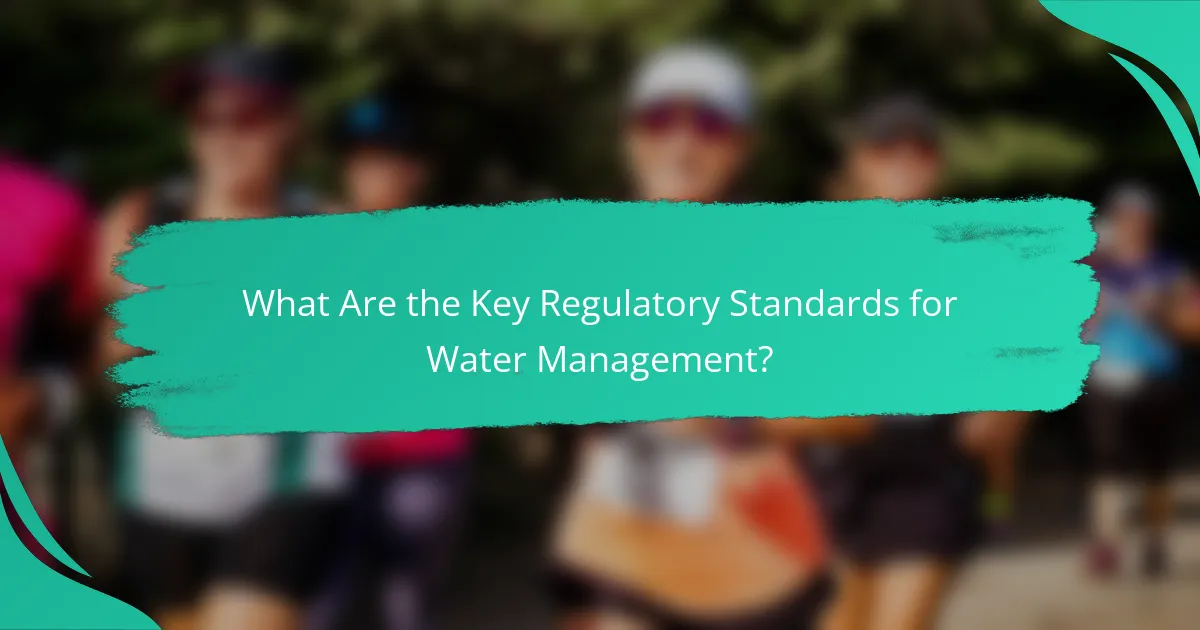
What Are the Key Regulatory Standards for Water Management?
The key regulatory standards for water management focus on ensuring safe and sustainable water use while protecting environmental resources. These standards are established at both federal and state levels, guiding practices to minimize pollution and manage water resources effectively.
Federal Standards
In the United States, federal water management standards are primarily governed by the Clean Water Act (CWA) and the Safe Drinking Water Act (SDWA). The CWA aims to restore and maintain the integrity of the nation’s waters by regulating pollutant discharges and setting water quality standards.
Under the CWA, the Environmental Protection Agency (EPA) establishes National Pollutant Discharge Elimination System (NPDES) permits, which control the discharge of pollutants into waterways. Compliance with these permits is crucial for industries and municipalities to avoid penalties and ensure environmental protection.
State-Specific Regulations
State-specific regulations can vary significantly, reflecting local environmental conditions and water needs. Each state may have its own water quality standards, which can be more stringent than federal requirements, addressing unique regional challenges such as drought or pollution sources.
For example, California has implemented strict regulations on water usage and quality, including the Sustainable Groundwater Management Act, which requires local agencies to develop plans for sustainable groundwater management. Businesses and local governments must stay informed about their state’s regulations to ensure compliance and avoid legal issues.
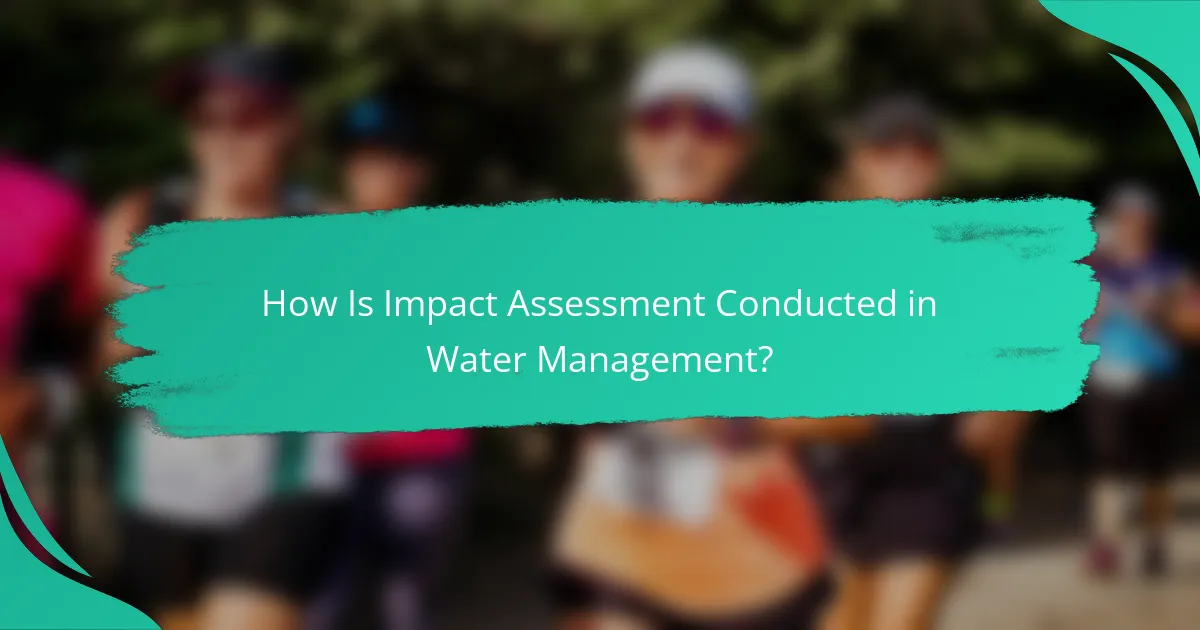
How Is Impact Assessment Conducted in Water Management?
Impact assessment in water management involves evaluating potential environmental effects before project implementation. This process ensures compliance with regulatory standards and helps mitigate adverse impacts on ecosystems and communities.
Environmental Impact Statements
Environmental Impact Statements (EIS) are comprehensive reports that detail the expected environmental effects of proposed water management projects. They typically include assessments of water quality, habitat disruption, and socio-economic impacts.
In many jurisdictions, an EIS is required by law for projects that may significantly affect the environment. For example, in the United States, the National Environmental Policy Act mandates an EIS for federal projects, while in the European Union, similar requirements exist under various directives.
Risk Assessment Procedures
Risk assessment procedures in water management evaluate the likelihood and severity of potential negative impacts from projects. This includes identifying hazards, assessing exposure levels, and determining the vulnerability of affected populations and ecosystems.
Common steps in risk assessment include hazard identification, dose-response assessment, exposure assessment, and risk characterization. For instance, assessing the risk of chemical runoff into water sources involves analyzing the chemicals used, their concentrations, and the proximity to water bodies.
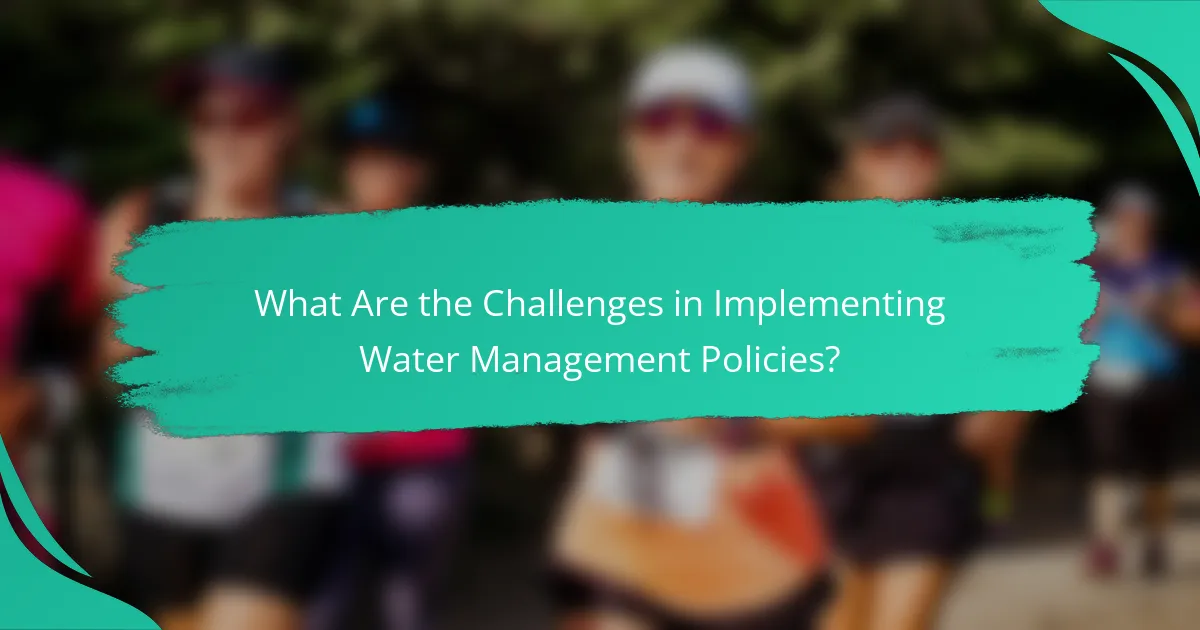
What Are the Challenges in Implementing Water Management Policies?
Implementing water management policies faces several challenges, including securing adequate funding, engaging stakeholders effectively, and ensuring compliance with regulatory standards. These obstacles can hinder the successful execution of policies aimed at sustainable water use and environmental protection.
Funding and Resources
Securing funding and resources is a critical challenge in water management policy implementation. Governments and organizations often face budget constraints, which can limit the scope of projects aimed at improving water infrastructure or conservation efforts. It is essential to explore various funding sources, such as government grants, public-private partnerships, and international aid.
Additionally, prioritizing projects based on cost-effectiveness and potential impact can help allocate limited resources efficiently. For instance, investing in water-efficient technologies may yield long-term savings and environmental benefits, making it a worthwhile focus for funding.
Stakeholder Engagement
Effective stakeholder engagement is vital for the successful implementation of water management policies. Engaging local communities, businesses, and environmental groups fosters collaboration and ensures that diverse perspectives are considered. This can lead to more comprehensive and accepted policies that address the needs of all parties involved.
To facilitate stakeholder engagement, policymakers should organize public meetings, workshops, and consultations. Providing clear information about the policies and their potential impacts can help build trust and encourage participation. Additionally, establishing feedback mechanisms allows stakeholders to voice their concerns and suggestions, enhancing the overall effectiveness of the policies.

How Do Technology Solutions Enhance Water Management?
Technology solutions significantly enhance water management by improving efficiency, accuracy, and compliance with environmental regulations. These tools enable better data collection, analysis, and monitoring, leading to more informed decision-making and sustainable practices.
Data Analytics Platforms
Data analytics platforms play a crucial role in water management by processing large volumes of data from various sources. They help identify trends, forecast demand, and optimize resource allocation, which can lead to cost savings and improved service delivery.
For effective use, organizations should focus on integrating real-time data feeds and historical datasets. This integration allows for more accurate modeling and scenario analysis, enabling better preparedness for water scarcity or flooding events.
Common pitfalls include relying on outdated data or failing to train staff on analytics tools. Regular training and updates can ensure that teams leverage the full potential of these platforms.
Remote Sensing Technologies
Remote sensing technologies enhance water management by providing real-time monitoring of water bodies and surrounding environments. These technologies, such as satellite imagery and drones, allow for the assessment of water quality, quantity, and usage patterns over large areas.
When implementing remote sensing, it’s essential to consider the resolution and frequency of data capture. Higher resolution images can provide more detailed insights, while frequent updates can help track changes due to seasonal variations or human activities.
Organizations should also be aware of regulatory compliance when using remote sensing data, especially regarding privacy and data sharing. Establishing clear protocols can help mitigate legal risks while maximizing the benefits of these technologies.
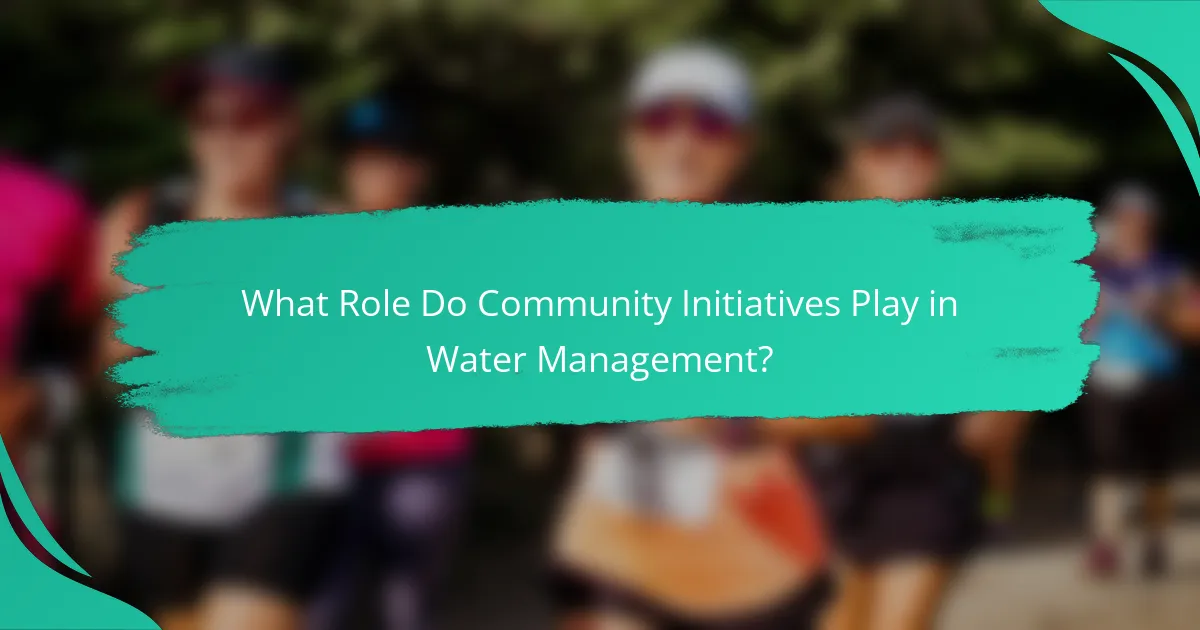
What Role Do Community Initiatives Play in Water Management?
Community initiatives are vital in water management as they foster local engagement and promote sustainable practices. These initiatives help raise awareness, encourage conservation, and ensure compliance with environmental regulations.
Public Awareness Campaigns
Public awareness campaigns educate communities about the importance of water conservation and proper management practices. These campaigns often include workshops, informational brochures, and social media outreach to inform residents about local water issues and solutions.
Effective campaigns can lead to significant behavioral changes, such as reducing water waste and promoting the use of water-efficient appliances. For example, a campaign might encourage households to install low-flow fixtures, which can reduce water usage by 20-30%.
Local Conservation Efforts
Local conservation efforts involve community-driven projects aimed at preserving water resources. These can include initiatives like tree planting, rainwater harvesting systems, and the restoration of wetlands, which enhance natural water filtration and storage.
Engaging community members in these efforts not only improves water quality but also strengthens local bonds. For instance, organizing clean-up days at local rivers or lakes can foster a sense of ownership and responsibility towards water resources.
